- Author
- Turner, Mike
- Subjects
- Biographies and personal histories, WWII operations, History - WW2
- Tags
-
- RAN Ships
- None noted.
- Publication
- June 2010 edition of the Naval Historical Review (all rights reserved)
Bombs and mines were rendered safe by the RAN in the United Kingdom, Europe and the Middle East during World War II. RAN personnel were highly decorated for their extraordinary achievements during Rendering Mines Safe (RMS) operations. ((In World War II ‘Rendering Mines Safe’ (RMS) applied to the rendering safe of all explosive ordnance. RMS was replaced by BMD (Bomb and Mine Disposal), and then by the current acronym EOD (Explosive Ordnance Disposal).)).
United Kingdom
Germany laid magnetic ground mines in British coastal waters from the very outset of the war. Initial minelaying was by surface craft (mainly E-boats) and submarines to avoid mine recovery. In spite of the agonized protests of the German Naval Staff the Luftwaffe insisted in joining in, and began mining on the night of 21/22 November 1939.
The Germans fitted anti-removal devices to their aerial mines, particularly in their bomb fuse, to prevent a mine being recovered. The German bomb fuse was both an anti-recovery device and a delayed-action bomb fuse. It was always fitted, and detonated the mine about 17 seconds after a mine was laid on land or in water less than 3.7 m deep. If a faulty fuse was disturbed during RMS it could run, and in unfavourable circumstances (for example underwater, in mud, or in shafts) the RMS officer had no chance of escape. Lieutenant James Kessack, GM, RANVR was killed in the UK in April 1941 when a bomb fuse ran and he could not escape.
Grand Admiral E. Raeder, C-in-C of the German Navy, informed Hitler that Britain might recover a magnetic mine and copy it within one to two years. In the event two magnetic mines were rendered safe by the Enemy Mining Section at HMS Vernon on 23 and 27 November 1939, almost as soon as aerial mining commenced. This was made possible by inaccurate laying of parachute-retarded mines by Luftwaffe aircraft and damage sustained by mines on laying. Exploitation of these mines led to rapid development of magnetic sweeps. There were five types of sweep in service in January 1940.
‘Yachties’
About 500 Australians officers went to the UK under the RAN Volunteer Reserve (RANVR) Yachtsmen Scheme to train and serve with the Royal Navy. They were known as ‘Yachties’, and nine of them were Sub Lieutenants who volunteered for RMS operations after they arrived in the UK.
The workload on the Enemy Mining Section was such that RANVR officers were quickly in the ‘deep end’ of RMS operations. For example Hugh Syme enlisted in the RANVR on 17 September 1940. He arrived in England on 27 October 1940 with fellow RANVR Probationary Temporary Sub Lieutenants Kessack, Mould and Reid. They completed only three weeks of the six week initial training course at the Officer Training School, RNVR at HMS King Alfred in November 1940. They were taken off course when they volunteered for ‘special duty’, and given a short course on RMS at Vernon. The ‘deep end’ for Syme was at Manchester in December 1940, and he was awarded the GM for rendering safe a mine in atrocious and hazardous conditions. A few weeks earlier Syme did not even know the meaning of the acronym RMS.
Anti-removal devices

The Australians encountered various special anti-removal devices, the most common being the ‘Zus 40’. When this anti-removal device was fitted beneath the bomb-fuse the mine would detonate if the bomb-fuse was removed without taking special precautions. Many of their operations were extraordinary in overcoming obstacles, and others were the first occasion on which a new type of mine was rendered safe whilst it was still armed.
At Weston-Super-Mare Lieutenant Syme rendered a ‘Sammy’ magnetic-acoustic mine safe in hazardous wet conditions that denied him electrical insulation. When cutting a lead he received a violent 180 volt shock. He cut two other leads knowing that he would receive the same violent shock each time. His skin peeled off several days later.
The German acoustic sensor was seismic and responded to the slightest vibration in the mine case. Rendering safe an armed acoustic mine was generally considered to be quite impossible. However on 28 June 1941 the ‘impossible’ was achieved for the first (and apparently only) time by an officer who had been invalided out of the AIF in early 1940 after a bout of pneumonia, Lieutenant John Mould, RANVR. This extremely difficult operation was in appalling mud at Trinity Sands on the Humber River. Mould was assisted by Lieutenant Geoffrey Turner (later Lieutenant Commander G.V. Turner, GC, GM, RNVR) and an unknown sailor.




